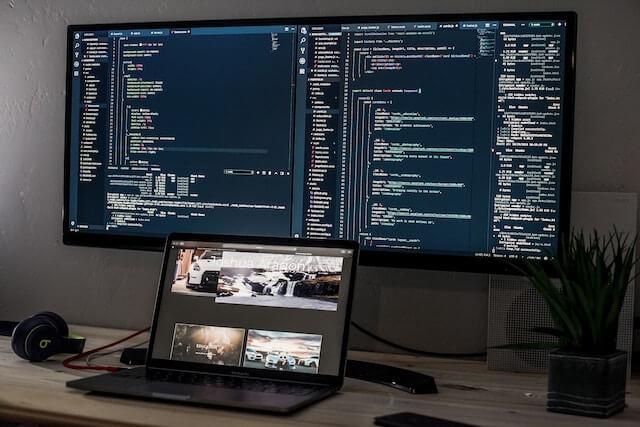It’s officially now an open secret that using multiple displays can go a long way in significantly improving your productivity. On the whole, the more screens you have to work with the more you can do. And, the more you can do, the better off you are.
All of this raises the important question; how many monitors can Windows 10 support?
It stands to reason that, when you’re able to properly answer this question, you’ll be in a much better position to accurately determine the most efficient way to set up your workspace. What’s more, in addition to finding the right answer to this question, it is also very important for users to take a moment to efficiently account for all the other variables that might in one way or the other come into play when the issue of multiple monitors comes up.
What all of this means, in the end, is that you need a detailed yet concise guide to walk you through all the relevant elements that are worthy of note here.
And that’s just what we’ll do!
The Netbook News team has done extensive research into this topic and we’ve compiled all that you would need to know when it comes to equipping your Windows 10 with the right number of monitors.
Without wasting time, let’s get into the thick of things now!
The Short Answer to How Many Monitors Can Windows 10 Support?
The number of monitors that Windows 10 can support is 10. According to Microsoft, the manufacturing company of the Windows 10 software, you can only get the best of the Windows 10 program when you fix the maximum number of monitors that you connect at or under this particular benchmark.
Anything that deviates from this is very likely to present results that you might not necessarily find pleasant.
Going Deeper Into How Many Monitors Windows 10 Can Support
Fine. You might be thinking; now, I have a fixed and precise answer to how many monitors can I connect to my Windows 10. Let me get on with my business now.
Well, you’ll have to hold off on that for a moment.
This is because, even though Microsoft says that Windows 10 can support a maximum of 10 monitors, that alone isn’t enough reason for you to go connect that many displays to your single device!
If you’re wondering why that is, it’s because the type of personal computer that you use comes into play to a major extent here. What this means in essence is that you would need to perform a considerable amount of tweaks on your device before you can get it to support that many monitors at once.
And even then, you would do well to remember that you’re putting the device under an incredible amount of strain.
What to Know About Connecting Multiple Monitors to Your Windows 10 Device
As some users may have started to realize by now, the issue of connecting multiple monitors to your Windows 10 PC is getting a little more complicated than you would have initially expected. This will inevitably happen because a typical multiple monitor setup for a Windows PC generally doesn’t exceed three.
Three is a comfortable number in this case because it gives users a more than decent reach. In the same vein, it doesn’t overly task the computer itself and doesn’t even require any third-party program or software to put in place. Most times, all you need to do is take advantage of the different ports that come with your computer to get what you need done.
As a result, for people who are planning to do considerably more with their computer devices, much more has to be done.
The first step down that road is checking precisely how many monitors can Windows 10 support for your particular device. As you would naturally expect, this figure will likely change depending on how sophisticated and advanced your device is.
To check this information on a Windows 10 computer, you have to make your way to the “Control Panel” of your device and check the information provided under “Display Properties”.
What you find there will play a major part in determining what your next line of action will be.
Major Variables That Influence The Number of Monitors That You Can Connect to Your Windows 10 Device
Before delving any deeper into the intricacies attached to the question of how many monitors Windows 10 can support, let’s take a moment to closely look at the variables that influence the amount of displays that you can get out of your computer in the first place.
It is certain that, with this tidbit of information, users will have a better and clearer picture of the best ways to get the most of monitor connectivity from their current or future laptop or desktop computer device.
Along those lines, the two most important elements that come into play in this department are:
The Graphics Processing Unit of Your Computer Device
The graphics processing unit or GPU of your computer device is perhaps the biggest factor to put into consideration when it comes to determining just how many monitors your computer device can cater to.
You may be wondering; but why is the GPU of my computer system so important in this area?
The simple answer to that question is that it’s your graphics processing unit that supports your central processing unit or CPU with rendering the graphics that we see. The GPU of your device integrates with your system via the high-definition multimedia interface (HDMI) ports and DisplayPort featured on your device.
What this means is that, in the end, the higher the number of ports made available on your device, the greater the number of monitors you’ll be able to conveniently connect to your system.
The Motherboard of Your Computer Device
Another equally important element that comes to play when it comes to properly answering the question of how many monitors can Windows 10 support is the type of motherboard that your computer device features.
For example, if your computer device features a motherboard with SLI support, you can rest assured that you will be able to connect a lot more monitors to your gadget. This is because SLI makes it possible for computers to support and run multiple GPUs simultaneously.
As a result, this gives you the latitude that you need to increase the number of outputs that your device offers. What’s more, the number of HDMI ports that are connected to your motherboard serves as a crucial factor to consider here as well. This is because, the more HDMI ports that there are, the higher the capacity of your GPU is likely to be.
What this means is that you just might have what it takes to connect all 10 monitors to your Windows 10 device!
As such, it never hurts to pay extremely close attention to the motherboard of your computer unit.
Top Reasons to Connect Multiple Monitors to Your Windows 10 Device
Now, even though you have the answer to the question of how many monitors can Windows 10 support question, you might not be all that enthused to push your computer device to the limit that way. One possible reason for this is that you might be asking yourself what would be the point of such an endeavor.
To help you make up your mind on whether or not to subscribe to a multiple monitor system with your Windows 10 device, here are a few points to consider.
One – Using Multiple Monitors Can Considerably Enhance Productivity
This is arguably the biggest perk of having a multiple monitor system in operation. Because you will have all of the information that you need immediately in front of you, you will be able to get more done in considerably less time.
The major advantage of using various screens at once in this scenario is that you won’t have to go through the hassle of switching between windows to find the information that you need. All of this goes a long way in ensuring that your workflow is fast, streamlined, and highly efficient.
Two – It Makes Organization Much Easier
Yet another thing that makes having a multiple monitor system setup worth considering is the fact that it helps you organize your workflow with minimal effort. This can come in handy if you frequently attend online meetings. All you’ll have to do is use one screen for the meeting proper while you use the other(s) to call up any documents or materials that might be germane to the meeting.
Three – It Makes Multitasking More Convenient
Because there will almost always be more to do and not enough time to do it, most employees are learning the art of multitasking. Having a multiple monitor setup can do much to enhance your multitasking goals, helping you see more rewards for your endeavors.
Conclusion
How many monitors can Windows 10 support? The answer to that is 10.
Whether your computer device in particular can support that many is a different affair entirely. In either case, you now know all that there is to know about using multiple monitors on Windows 10.
So, go make your workspace better now!

Kenny Trinh is a seasoned expert in the field of laptops and technology, boasting an extensive background enriched by years of hands-on experience and in-depth research. With a keen eye for innovation and a passion for staying ahead of the technological curve, Kenny has established himself as a trusted voice in the tech community. Holding a prestigious degree in Computer Science, he combines his academic insights with practical expertise to deliver valuable insights and recommendations to his readers and followers. Through his work, Kenny aims to demystify complex tech concepts, empowering individuals to make informed decisions and optimize their digital experiences.
